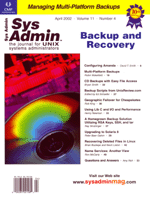 syslog syslog
The ACM news wire had a link to an interesting article about storage
capacity recently. Written by Anne Michaud for the Boston Globe
(p. C2, 1/14/2002), the article says, "Engineers are beginning
to perceive a wall at the end of the road of information that can
be stored on a hard disk. Some say the wall is two years out, others
estimate a decade. In either case, after unexpected capacity expansion
in the last dozen years, experts say they are witnessing the beginning
of the end."
Various researchers, however, are looking for ways to stave off
this impending storage crisis. For example, a consortium led by
Seagate Technologies and Carnegie Mellon University is researching
a technology called heat-assisted magnetic recording (or HAMR).
HAMR technology involves supplementing magnetic disk drives, which
use magnetic heads to read and write data onto spinning platters.
According to Michaud's article, "As storage density
grows, the bits are becoming so small that soon they will become
unstable due to a phenomenon known as superparamagnetism. The solution
is to use a more stable medium, but today's magnetic heads
can't write data to such a medium. HAMR solves the problem
by heating the medium with a laser-generated beam at the precise
spot where data bits are being recorded. When heated, the medium
becomes easier to write to, and the rapid cooling stabilizes the
written data." According to Seagate, if implemented, HAMR technology
could enable the magnetic data storage industry to extend its technological
advancement for a decade or more beyond what could otherwise be
anticipated. I look forward to seeing how this and other research
into storage technology plays out over the next few years.
In this storage and backup focused issue of Sys Admin,
Henry Newman contributes an article on I/O and performance-related
topics. Newman has worked in the IT industry for more than 20 years.
In positions with Cray Research and now at a consulting organization,
he has provided expertise in systems architecture and performance
analysis to customers in government, scientific research, and industry.
His focus is on high-performance computing and advanced UNIX systems,
and he previously wrote a monthly storage column for Server/Workstation
Expert magazine. For Sys Admin this month, Newman starts
at the beginning and discusses how I/O works from the application.
In his next few articles, he plans to address the whole I/O path
and the issues with performance and tuning for the server hardware,
operating system, file system, and applications.
Sincerely yours,
Amber Ankerholz
Editor in Chief
|

